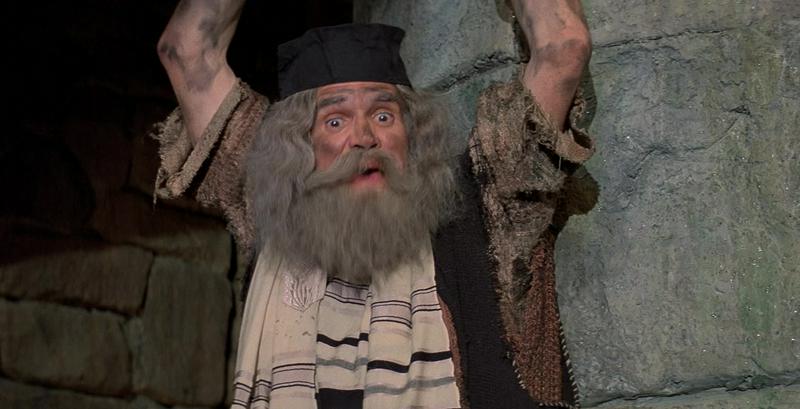Mel Brooks’ Farcical Take On The History Of The World
By | December 2, 2021

In 1981, Mel Brooks wrote, directed, produced, and acted in History of the World, Part I. Although the film received mediocre reviews, for the most part, it performed relatively well at the box office, grossing $31.7 million. Brooks’ earlier films had been very successful, and this one did not live up to the earlier films. Roger Ebert gave the film only two stars and said that it is "a rambling, undisciplined, sometimes embarrassing failure from one of the most gifted comic filmmakers around. What went wrong? Brooks never seems to have a clear idea of the rationale of his movie, so there's no confident narrative impetus to carry it along." Despite the overall negative reviews of the film, several critics have noted its humor, with one, Jonathan Rosenbaum, arguing that the film is a guilty pleasure and that “the wonderful stuff is so funny that it makes most of the awful stuff tolerable.”
The film was inspired in 1979 when a grip who had worked on High Anxiety asked Brooks about his plans for his next film. Brooks responded by saying that he was planning “the biggest movie ever made. It's called 'History of the World.''

Making Music In The Stone Age
The film, which occasionally seems like a series of sketches rather than a single narrative, parodies historical epics, and as a “history of the world,” it starts with The Stone Age. Orson Welles introduces the story in his booming voice, pronouncing, “And the ape stood, and became man.” In The Stone Age, the cavemen, including Sid Caesar, not only discover fire, and the first tools, but also create the first art, which leads to the first critic, and invent music as they use rocks to bash each other’s feet. Their chorus of screams inevitably evolves into Handel’s “Hallelujah Chorus.” Orson Welles then proceeds to narrate the remaining segments. He was paid a total of $25,000 for work that required less than a day to complete.

The Old Testament Almost Didn't Happen
In the next segment, The Old Testament, Mel Brooks plays the role of Moses who descends Mount Sinai with three tablets which contain the Law of God (with God voiced by Carl Reiner, who is uncredited). After he tells the people, "The Lord Jehovah has given unto you these fifteen..." he drops one, which breaks. He then says, “Oy... ten! TEN Commandments! For all to obey!" This segment almost didn’t appear in the film, but Brooks was inspired by the set they used for the Stone Age, and thus, the scene was born prior to the Roman Empire.

The Stand-up Philosopher
In the Roman Empire, Brooks appears as Comicus, the “stand-up philosopher in the Roman Empire. Comicus falls in love with a Vestal Virgin, Miriam, played by Mary-Margaret Humes, and becomes friends with an Ethiopian slave, Josephus. Originally, Brooks had planned to cast Richard Pryor as Josephus, but Pryor was hospitalized two days before they were planning to shoot his part. At the suggestion of Madeline Kahn, he cast Gregory Hines instead of cutting the role altogether. Dom DeLuise plays Emperor Nero, the butt of Comicus’s jokes. After Comicus and Josephus (who poured wine on Nero) “fight” their way out of the palace, they use smoke from “Roman Red” marijuana to confuse the Roman army and escape. The escapees sail to Judea, and Comicus waits tables at a restaurant, where he witnesses the Last Supper. Leonardo Da Vinci arrives to paint them, and Comicus appears in the painting, holding a silver plate that looks like a halo behind Jesus, played by John Hurt.

Singing And Dancing Through Torture
The set for the next segment, The Spanish Inquisition, cost $1 million. In it, Brooks appears as Torquemada with a herald introducing him, saying "you can't Torquemada anything" (you can’t talk him outta anything) when the condemned plea for mercy. The segment also has cameos by Jackie Mason and Ronny Graham, who wrote the Busby Berkeley style song that is central to the segment. In addition to the song and dance number, nuns perform an aquatic water ballet. Incidentally, Brooks was hesitant about the inclusion of the song as he was concerned that it may have crossed a line with some of the lyrics.

Escaping Execution Takes A Miracle
The film then arrives at the French Revolution, where Cloris Leachman as Madame Defarge convinces a mob in her tavern to plot the revolution. Brooks is also in this segment, playing King Louis of France, whose advisor Count de Monet (Harvey Korman) warns him about the revolution. De Monet convinces the king to find a stand-in, which he does: Jacques, the garçon de pisse (also played by Brooks). Eventually, Jacques is taken to the guillotine, where, as a final request, he asks for Novocain. This, of course, is an anachronism, which the executioner recognizes, then Jacques says “I’ll wait.” Rimbaud, a beautiful woman who had offered her virginity to the “king” notes that “only a miracle can save him now,” just as Josephus arrives with Miracle, a horse from the Roman Empire segment, helping them to escape, riding off towards a mountain which has the words “THE END”.

The Title Of The Film Was Part Of The Humor
This, though, is not the end, as the movie really ends with “Previews of Coming Attractions,” a mock teaser that includes "Hitler on Ice" and “Jews in Space.” However, at that point there were no plans for Part II since the title of the film was part of the comedy; Sir Walter Raleigh had only written the first volume of The History of the World Volume 1 before he was executed. However, on October 18, 2021, Hulu announced a sequel, so it appears this might not be “the end.”
